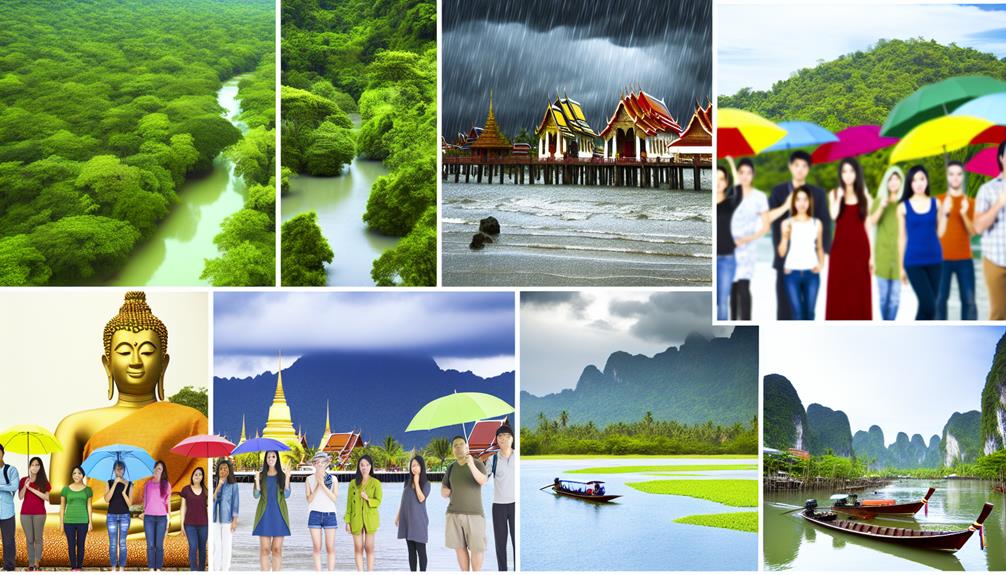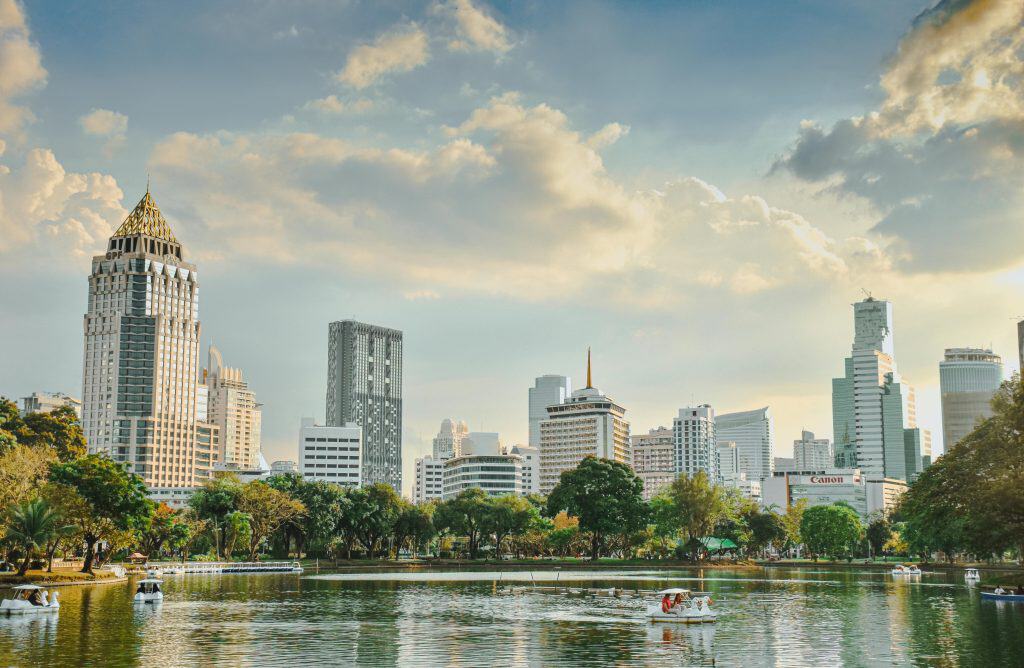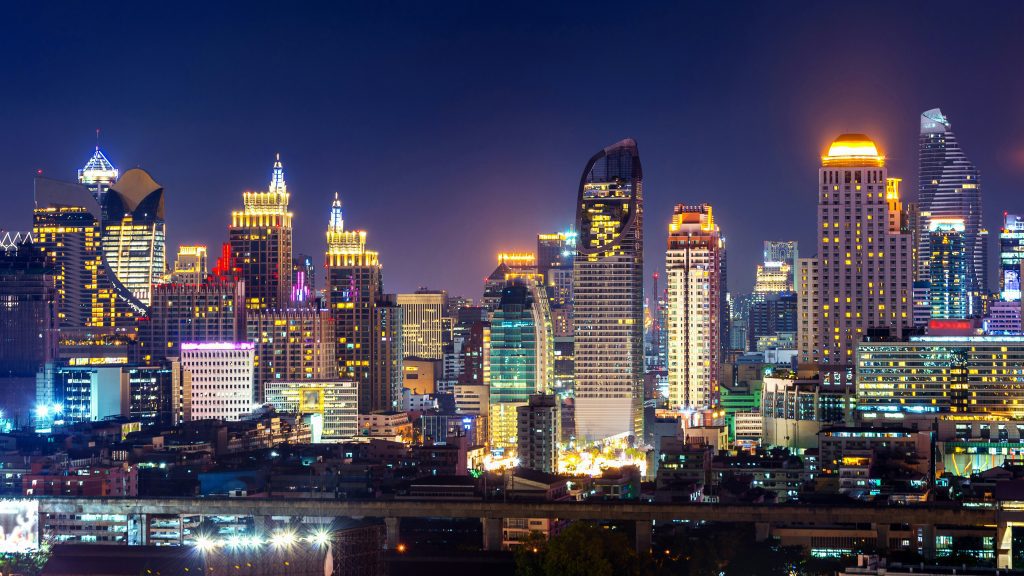As the monsoon clouds gather over the picturesque landscape of Thailand, much like a curtain preparing to set the stage for a dramatic play, you can’t help but wonder how the imminent downpour will reshape your travel experience.
You’re aware that the rainy season brings a palette of changes, quietly altering everything from your daily itineraries to the cost of your accommodation.
The lush greenery and cascading waterfalls promise an ecological spectacle, yet the persistent rains also pose unique challenges to outdoor adventures and local explorations.
You might find yourself questioning how these seasonal shifts affect the very fabric of transportation and accessibility in a land famed for its hospitality and vibrant culture.
As you consider these facets, you’re poised on the brink of uncovering the multifaceted impacts of Thailand’s rainy season on tourism, each more intriguing than the last.
Altered Travel Itineraries
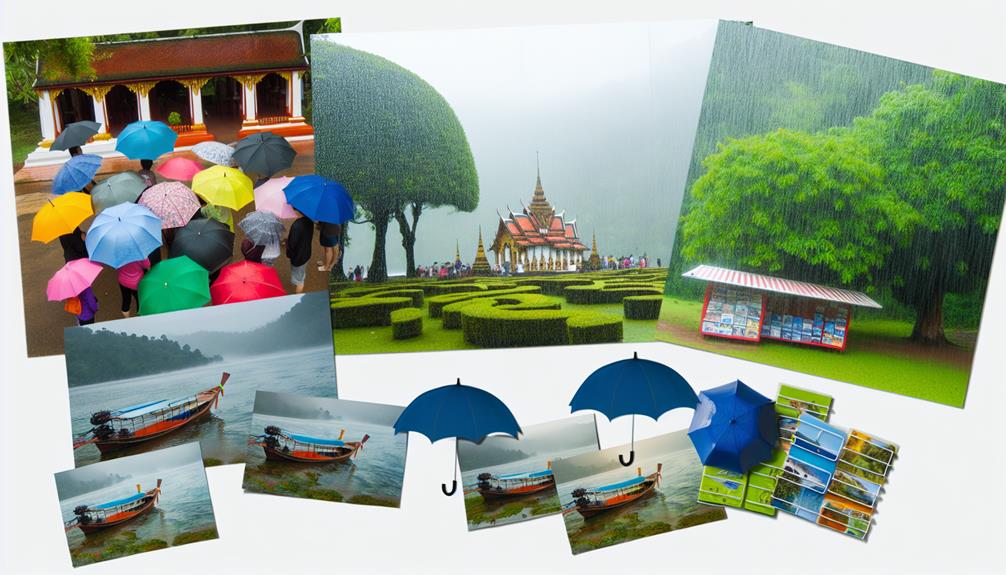
The rainy season in Thailand often necessitates changes to your travel plans, as downpours can disrupt transportation and outdoor activities. You’ll find yourself swapping beach days for museum visits or indulging in long, leisurely meals at covered markets instead of street food stalls drenched by the monsoon showers. It’s essential to stay flexible, as ferries to islands might be delayed or canceled and flights can face weather-related scheduling challenges.
You must also consider the unpredictability of rain; it could pour for hours or simply offer a quick, refreshing shower. Either way, you’ll need to adapt quickly. Outdoor trekking, for instance, might become treacherous, and you’ll have to exchange it for safer, indoor alternatives.
Shifts in Accommodation Costs
As the rainy season descends upon Thailand, you’ll notice accommodation prices fluctuating, often presenting opportunities for significant savings. During this time, many hotels and resorts lower their rates to attract travelers. You’re likely to find that rooms normally at a premium during peak season become much more affordable.
However, don’t just jump at the first discount you see. It’s smart to shop around, as some places might offer steeper discounts or value-added packages that include meals or spa services. Keep an eye out for these deals; they can enhance your stay without stretching your budget.
You should also consider the type of accommodation. Luxury resorts may offer the most dramatic price drops, but guesthouses and budget hotels often have competitive rates year-round. If you’re flexible with your travel dates and aren’t set on a specific type of lodging, you could score a real bargain.
Ecological and Scenic Changes

While exploring Thailand during the rainy season, you’ll witness a remarkable transformation in the country’s landscapes and ecosystems. The once arid fields bloom with lush greenery, rivers and waterfalls swell with vigor, and the forests sing with the calls of wildlife stirred by the abundance of water. This period of rejuvenation breathes life into the scenery, offering you a visual feast of vibrant flora and thriving fauna.
As you trek through the verdant jungles, you’ll notice the air is fresher, the foliage denser, and the sense of adventure heightened by the slick, rain-soaked paths that challenge even the most experienced hikers. The rains also bring about a change in the behavior of animals, with many species emerging to mate and forage, giving you a rare glimpse into their world.
Moreover, the rainy season enhances the natural beauty of Thailand’s scenic spots. Iconic places like the Phi Phi Islands and the beaches of Phuket transform into serene escapes with fewer crowds, allowing you to appreciate their beauty in solitude.
Impact on Outdoor Activities
Despite the picturesque landscapes, the rainy season can significantly affect your plans for outdoor activities in Thailand. You’ll find that trekking, rock climbing, and even leisurely beach days are subject to the whims of the weather. The trails you’re itching to hike may be slick and muddy, making your adventure more challenging and potentially hazardous. The limestone cliffs, a climber’s paradise during the dry months, become slippery and treacherous when wet.
You might also have to rethink those snorkeling or diving trips, as the sea can be rough, and visibility underwater is reduced. The rain doesn’t just come in a steady drizzle; it often pours down in heavy, sudden bursts, disrupting even the simplest activities like street food hopping or temple visiting. And while you can still push through with some plans, you’ll need to be flexible and prepared for quick changes.
Variation in Local Experiences
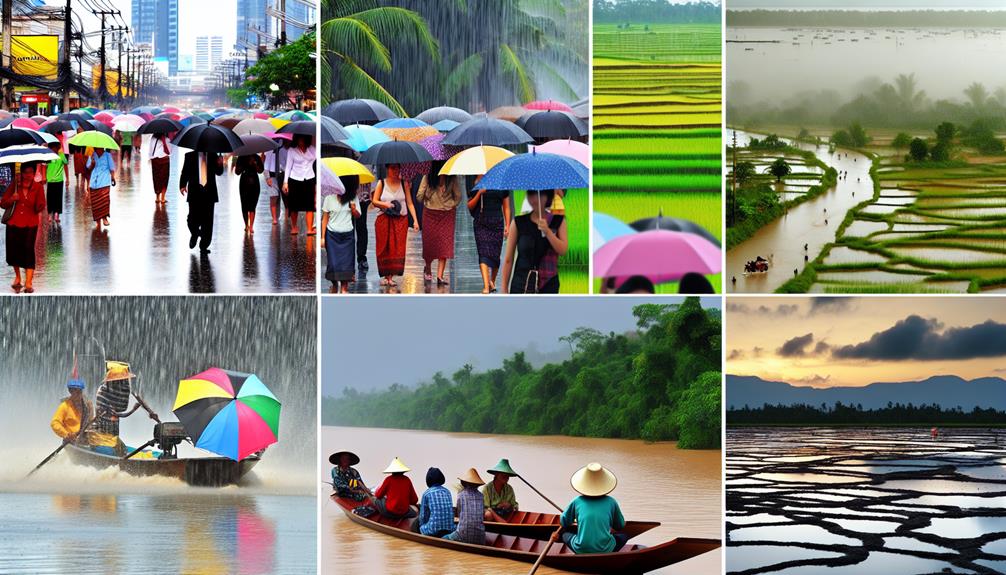
Rainy season experiences differ significantly across Thailand, with some regions facing mild showers while others contend with severe flooding. If you’re planning a trip during this time, you’ll find that what awaits you can vary drastically depending on where you’re headed.
In the north, you might encounter brief, refreshing downpours that cool the air and bring out the lush greenery. It’s a perfect time for you to indulge in the local cuisine at a cozy café while watching the rain.
Down south, however, things can get a bit more intense. Coastal areas, especially on the western side facing the Andaman Sea, can see prolonged periods of rainfall that disrupt beach activities and boat tours. You’ll need to be more flexible with your plans here, as the weather can change quickly and without much warning.
In cities like Bangkok, the rainy season brings a mix of inconvenience and relief. You’ll navigate through busy streets under the protection of your umbrella, sometimes wading through waterlogged sois (alleys). But don’t let this dampen your spirit; the city’s vibrant life doesn’t stop, and neither should you. Just arm yourself with waterproof gear and a sense of adventure, and you’ll discover a different side of Thailand that’s equally captivating.
Transportation and Accessibility Challenges
Navigating Thailand during the rainy season often means contending with transportation delays and limited access to certain areas due to flooding. You’ll find that roads can quickly become impassable, especially in rural regions or those with poor drainage systems. If you’re planning on driving, you’re likely to encounter potholes that fill with water, concealing their depth and posing risks to your vehicle’s suspension.
When it comes to public transportation, be prepared for schedule disruptions. Trains and buses are prone to delays as the tracks and roads they travel on may be submerged or damaged. You’ll need to factor in extra travel time to your itinerary to account for these potential hiccups. Additionally, if you’re looking to visit islands or remote locations, boat services might be less frequent or even suspended due to rough sea conditions.
It’s wise to stay updated on local weather reports and advisories. They’ll provide you with crucial information on which routes or modes of transportation to avoid.
Lastly, always have a backup plan. Whether it’s an alternative destination or a different means of getting around, flexibility is key to ensuring your travel plans in Thailand aren’t washed away by the rainy season’s challenges.
Frequently Asked Questions
How Does the Rainy Season in Thailand Affect Local Wildlife and Marine Life Activities for Tourists?
You’ll find fewer wildlife sightings and limited marine activities during the rainy season due to rough seas and animals seeking shelter from the frequent downpours, impacting your tourist experience.
What Are the Health and Safety Precautions Tourists Should Take During Thailand’s Rainy Season?
You should pack waterproof gear, stay updated on weather alerts, avoid flood-prone areas, and ensure you’re up-to-date with vaccinations to protect against rainy season-related illnesses while traveling.
How Does the Rainy Season Influence Traditional Thai Events and Festivals?
You’ll find that traditional Thai events and festivals are often rescheduled or adapted to cope with the rainy season’s impact, ensuring celebrations can continue despite the wetter, more unpredictable weather.
Are There Any Specific Regional Cuisines or Dishes That Are Unique to the Rainy Season in Thailand?
Yes, you’ll find unique regional dishes during Thailand’s rainy season, like spicy soups and stews that locals enjoy to warm up and boost immunity during the cooler, wetter months.
How Do Emergency Services in Thailand Respond to the Increased Risks of Flooding and Other Weather-Related Incidents During the Rainy Season?
You’ll find that during the rainy season, Thailand’s emergency services ramp up their readiness, deploying more units for rapid response to floods and weather incidents to ensure residents and visitors remain safe.
Conclusion
As you plan your Thailand adventure, remember the rainy season reshapes your experience. Your itinerary might need tweaking, but you’ll save on accommodations.
The lush landscapes will dazzle you, even as some outdoor activities become trickier. Embrace the unique local vibes and flavors this season brings, but stay mindful of potential transport hiccups.
Rain or shine, Thailand’s charm isn’t dampened—so pack your raincoat and dive into the monsoon magic with both feet!

